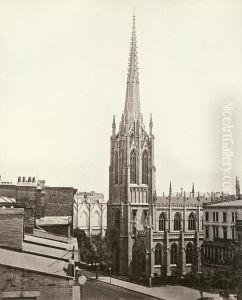William England Paintings
William England was a notable British photographer whose work spanned several decades in the 19th century, making significant contributions to the fields of landscape and travel photography. Born in 1830, England began his career in the era when photography was still in its infancy, developing a keen eye for capturing the essence of his subjects, which ranged from the urban landscapes of Europe to the natural beauty of North America.
England's work is particularly remembered for its role in the early days of photojournalism and for his association with the London Stereoscopic Company, one of the leading producers of stereoscopic images. Stereoscopy was a revolutionary technique at the time, offering viewers a three-dimensional viewing experience, and England was at the forefront of this technology, creating images that were both technically innovative and visually captivating.
Throughout the 1850s and 1860s, England embarked on numerous travels, capturing the landscapes, architecture, and people of places as varied as Switzerland, Italy, and the United States. His photographs not only provided a glimpse into the varied cultures and landscapes of these regions but also showcased his ability to adapt to and exploit the rapidly changing photographic technologies of his time.
One of the highlights of England's career was his coverage of the 1867 Paris Exposition, where his work gained international recognition. His photographs from this event are considered some of the earliest examples of photojournalism, capturing the grandeur and scale of the exposition with a level of detail and clarity that was unprecedented at the time.
Despite the fame and recognition he achieved during his lifetime, England's contributions to photography have not always been widely acknowledged in the broader history of the medium. Nevertheless, his work remains an important part of the 19th-century photographic canon, offering insight into the technological innovations and cultural landscapes of the era. William England passed away in 1896, leaving behind a legacy that continues to be appreciated by historians and photography enthusiasts alike.
